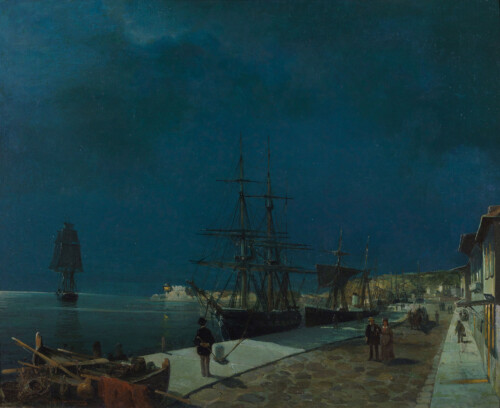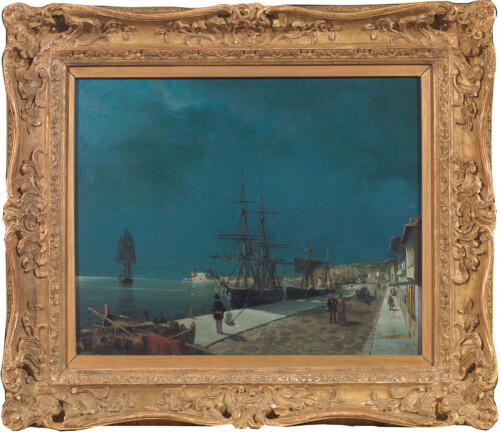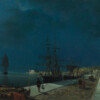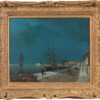| 11 |
Greek, 1837 -1907
Moonlit harbour of Volos
oil on canvas
signed lower left
circa 1855 - 1890
41.5 x 53 cm
PROVENANCE
private collection, Athens
LITERATURE
Manolis Vlachos, Volanakis, Peak Editions, 2016, pages 294-295, illustrated
| sold for 35 355.00 € |
Constantinos Volanakis was born on the island of Crete in 1837.
In 1865 he moved to Munich to study at The Royal Academy of Fine Arts. He was taught by Karl von Piloty.
His main interest from early on was in seascapes. He studied 17th century Dutch Masters and Italian 'Vedutta' masters A. Canaletto and F. Guardi.
In 1868 he presented 'The battle of Lissa' at the Austrian Artists' Society. The work was based on an incident during the war between the Austrians and the Italians. The painting was greatly admired and was acquired by Emperor Franz Josef I of Austria.
In 1877 he exhibited 'The battle of Trafalgar' in London; the work was bought by the British Naval Ministry.
In 1883 he returned to Greece due to his wife’s health problems caused by the cold climate of Munich. On his return to Athens Volanakis became a professor at The Athens School of Fine Arts.
Volanakis is regarded as a great nineteenth century marine painter because of his masterful representation of ships, detailed recordings of naval battles and sensitive atmospheric renderings.
His work is housed in prominent museums and private collections in Greece, Germany and elsewhere.
Manolis Vlachos in his book Volanakis, 2016, comments on the series of works by the artist on the Harbour of Volos:
"Ο ζωγράφος επανέλαβε το ίδιο θέμα αρκετές φορές σε διάφορες ώρες της ημέρας ή τη νύχτα, είναι δε αυτό που διεκδικεί τα πρωτεία, σε αριθμό πινάκων, από το λιμάνι του Πειραιά. Είναι φανερό ότι, εκτός από το εύρος του χώρου και την κίνηση της προβλήτας, αυτό που επέσυρε την προσοχή του καλλιτέχνη είναι το σχήμα του, η βαριά, σιγμοειδής γραμμή και η δυναμική ανέλιξη της, με την οποία άνετα συνδέονται τα σκάφη.
Το Λιμάνι του Βόλου –σε οιανδήποτε εκδοχή του- η παράσταση έχει ως βάση τη συνάντηση της καμπύλης και του κατακόρυφου άξονα, σχήμα που ευνοεί τη συσπείρωση και ανάπτυξη των θεμάτων στην προκυμαία και στη θάλασσα. Ο Βολανάκης, αντίθετα από τον Αλτάμουρα που αγαπά τις απομακρυσμένες απόψεις, προτιμά να εισάγει τον θεατή μέσα στο έργο και τον ξεναγεί. Αλλά η περιγραφή του, επιλεκτική, και σημαίνουσα παρά τον πραγματισμό της, ισοδυναμεί με ποιητική αποκάλυψη."



